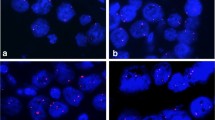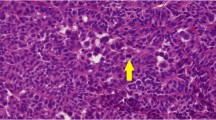Abstract
The DNA stemline ploidy was measured by flow cytometry (FCM) in 129 samples from paraffin-embedded primary testicular tumours (61 seminomas, 68 non-seminomas). Only one DNA stemline was found in 38 seminomas and 44 non-seminomas. Two seminomas and one non-seminoma were DNA diploid, the other tumours being non-diploid. Twenty-three seminomas and 24 non-seminomas displayed two or three DNA stemlines. The median minimal DNA index (DI) of all seminomas was significantly higher than that of all non-seminomas (1.58 vs 1.43; P: 0.008). Three seminomas removed from two monozygotic twins within 1 week had DIs of 1.66, 1.56 and 1.59. In this limited series there was no association between DNA ploidy of the primary tumour and the metastatic status for either seminomas or non-seminomas. The results support the pathogenetic model stating that at least some (if not all) non-seminomas develop from a seminoma by additional chromosomal aberration. The clinical relevance of DNA stemline ploidy has to be further evaluated in larger series.
Similar content being viewed by others
Author information
Authors and Affiliations
Rights and permissions
About this article
Cite this article
Fosså, S., Nesland, J., Pettersen, E. et al. DNA ploidy in primary testicular cancer. Br J Cancer 64, 948–952 (1991). https://doi.org/10.1038/bjc.1991.432
Issue Date:
DOI: https://doi.org/10.1038/bjc.1991.432
- Springer Nature Limited
This article is cited by
-
DNA ploidy pattern in pure seminomas
Pathology & Oncology Research (1995)




